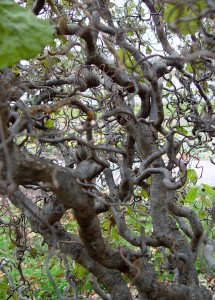Better Naked
November 11th, 2011
Now that the leaves are off plants for the season, the landscape looks distinctly more winterish than autumnish.
Bare doesn’t mean boring and barren, though.
The annual dropping of the leaves, in some cases, exposes hidden or overshadowed assets of plants.
A few actually look better naked.
Case in point: the Harry Lauder’s walking stick (Corylus avellana ‘Contorta’), a shrubby version of filbert grown mainly for its twisty, contorted branch structure.
Summer leaves hide most of that interest. Then when Japanese beetles and heat-induced scorching of the leaves beat it up, this plant looks horrid.
But when the plant finally has the good sense to shed its ratty leaves in fall, its nakedness unveils the plant’s hidden curiosity. You almost wish Harry would die to keep it leafless for good.
Another beauty unveiled is the red-twig dogwood (Cornus sericea) and its sister, the yellow-twig dogwood.
These are different than the white- and pink-blooming trees most people know as dogwoods.
Red-twigs and yellow-twigs are multi-stemmed shrubs that grow to 6 feet tall and wide. They don’t do anything terribly exciting in the growing season, other than make a few half-hearted attempts at white flower clusters followed by small white fruits.
When the leaves go down, though, bare upright stems of bright red and golden yellow literally glow in the late-afternoon autumn sun. They’re particularly stunning when fresh snow drops around their ankles.
Cut both of these shrub dogwoods nearly to the ground at the end of each winter to encourage all new stems, which color best in their first winter.
A third November stunner is the coralbark maple (Acer palmatum ‘Sango Kaku’), a 20-footish small tree with pointed leaves of light green.
It’s good-looking all season, but the highlight is when dropped leaves expose the neon-coral trunk and branches.
Just give Sango Kaku good drainage, water in dry weather and a wind-protected spot, ideally out of direct afternoon sun.
Few people load up on winter-interest plants because that’s not when we’re at the garden center.
We’re buying in spring and early summer — especially the second Saturday in May.
Clothed in alluring pink blossoms and variegated foliage, the early-season show-offs win the popularity contest every time.
That’s not a problem if you can’t bear to look out the window now for fear of seeing the season’s first ice storm. But if you’re a hopeless plant geek whose growing season is never over, it pays to make some notes.
Besides the above three, you might look for other plants with interesting bark.
Fans of peeling bark know the white birch and probably even river birch (Betula papyrifera and nigra), but not as well known is the exquisite paperbark maple (Acer griseum).
This slow-growing, mid-sized tree not only has rust-colored peeling bark, it’s got beautiful red fall foliage.
The dawn redwood (Metasequoia glyptostroboides) — a leaf-dropping needled tree once thought to be extinct — is a 50-plus-footer with rusty-cinnamon shredded bark.
A few other small trees have smooth bark that flakes off to leave a two-tone, Dalmation-like appearance. Some of my favorites are the Korean and Japanese stewartias (Stewartia koreana and pseudocamellia), Persian ironwood (Parrotia persica), Kousa dogwood (Cornus kousa) and even most crape myrtles (Lagerstroemia) as they age.
(Click here to see more detailed profiles with pictures of most of these.)
Don’t overlook shrubs for barking beauty.
Two of the best are ninebark (Physocarpus opulifolius) and oakleaf hydrangea (Hydrangea quercifolia). Both are 6- to 10-foot native shrubs that pair their peeling stems with summer flowers and brilliant fall foliage — true four-season winners.
Like Harry Lauder’s walking stick, just about any Japanese maple offers beauty in its branch structure. Especially nice are the weeping ones.
Really, any weeping leaf-dropping tree (cherry, redbud, crabapple, snowbell, katsura, etc.) looks nearly as good in winter as in the growing season — provided you’ve thinned it to avoid too much clutter inside the umbrella.
Any tree trained into an espalier or other unnatural form also should look good this time of year.
Pick up one last hurrah from the few shrubs and trees that hang onto their fruits later in fall.
Birds and natural dropping de-fruit the majority of woody plants by the time the leaves drop, but a few thrifty souls are reluctant to give up the bounty.
Tops on that list is the winterberry holly (Ilex verticillata), a leaf-dropping holly whose females get bright red, orange or gold berries when pollinated by a suitable male.
Birds apparently aren’t real crazy about the flavor of winterberries, so they let these alone until late winter when there’s nothing around any better.
Beautyberry, hawthorn, pyracantha, cotoneaster, nandina, some viburnums and evergreen junipers and hollies are others that offer late-fall and/or winter fruit.
If you look, there’s still something going on out there. Hopefully, it’s just not any blizzards yet.










